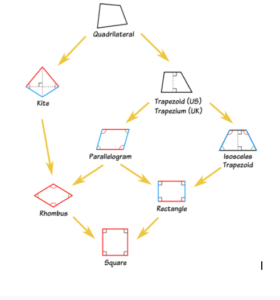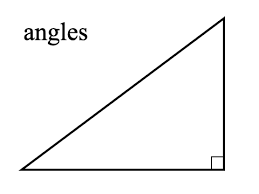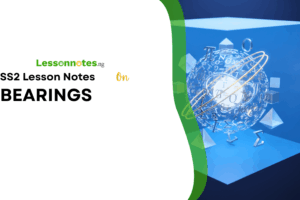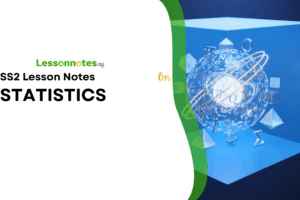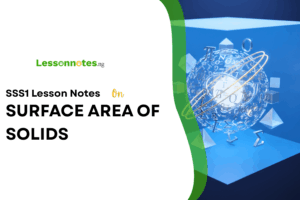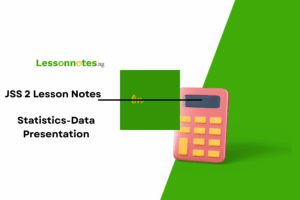Geometry: Plane Shapes & Their Properties JSS1 Mathematics Lesson Note
Download Lesson NoteTopic: Geometry: Plane Shapes & Their Properties
GEOMETRY (PLANE SHAPES AND THEIR PROPERTIES)
There are two types of plane shapes
Regular and irregular shapes.
TRIANGLES: A triangle is a three-sided plane shape with three angles.
Types and Properties of Triangles
Equilateral Triangles
Triangles with all three sides equal in length and all three angles equal in magnitude are called equilateral triangles. Since the angles in a triangle sum to 180° and the size of each angle is the same in an equilateral triangle, the angles are all 60°.
![]()
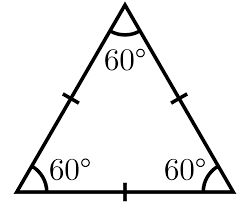
Isosceles Triangles
Isosceles triangles are triangles with two sides equal in length and two angles equal in magnitude.

Scalene Triangles
A scalene triangle has no sides equal in length and no angles equal in magnitude.
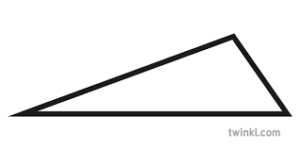
Right-Angled Triangles
Right-angled triangles are triangles with one of their angles equal to 90° (i.e. a right angle).
QUADRILATERALS
“Quadrilateral” just means “four sides” (quad means four, lateral means side). A Quadrilateral has four sides, it is 2-dimensional (a flat shape), closed (the lines join up), and has straight sides.
Types of Quadrilaterals
There are special types of quadrilaterals:
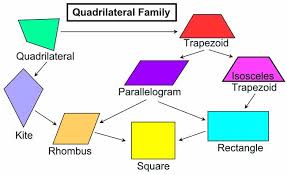
Some types are also included in the definition of other types! For example, a square, a rhombus, and a rectangle are also parallelograms.
TYPES AND PROPERTIES OF QUADRILATERALS
Quadrilaterals are any four-sided figure joined by four straight lines; that is, quadrilaterals are four-sided polygons.
Properties of Quadrilaterals:
-Four sides.
-Four vertices (corners).
-Interior angles sum to 360°.
-Exterior angles sum to 360°.
Things to Know:
Diagonals are line segments that join two opposite vertices (corners).
Two sides are adjacent if they share a common vertex.
Two angles are adjacent if they share a common side.

RECTANGLE
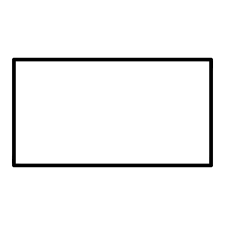
A closed planar quadrilateral with opposite sides of equal length and with four right angles. A square is a degenerate rectangle with. The area of the rectangle is, and its polygon diagonals are of length A rectangle is a four-sided shape where every angle is a right angle (90°). Also, opposite sides are parallel and of equal length.
RHOMBUS

A quadrilateral with both pairs of opposite sides parallel and all sides the same length, i.e., an equilateral parallelogram. The word rhomb is sometimes used instead of a rhombus, and a rhombus is sometimes also called a diamond. A rhombus is sometimes called a lozenge.
The polygon diagonals of a rhombus are perpendicular and satisfy
A rhombus is a four-sided shape where all sides have equal length. Also, opposite sides are parallel, and opposite angles are equal.
Another interesting thing is that the diagonals (dashed lines in the second figure) meet in the middle at a right angle. In other words, they “bisect” (cut in half) each other at right angles.
A rhombus is sometimes called a rhomb or a diamond.
SQUARE
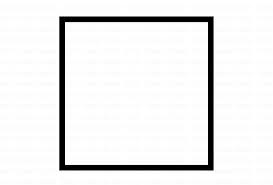
The term “square” can be used to mean either a square number (” is the square of “) or a geometric figure consisting of a convex quadrilateral with sides of equal length that are positioned at right angles to each other as illustrated above. In other words, a square is a regular polygon with four sides.
The perimeter of a square with side length is and the Area is
A parallelogram has opposite sides parallel and equal in length. Also, opposite angles are equal (angles “a” are the same, and angles “b” are the same).
NOTE: Squares, Rectangles, and Rhombuses are all types of parallelograms.

Trapezium

Isosceles Trapezium
The Kite

It has two pairs of sides. Each pair is made up of adjacent sides (they meet) that are equal in length. The angles are equal where the pairs meet. Diagonals (dashed lines) meet at a right angle, and one of the diagonals bisects (cuts equally in half) the other.
A planar convex quadrilateral consists of two adjacent sides of length and the other two sides of length. The rhombus is a special case of the kite, and the lozenge is a special case of the rhombus. The area of a kite is given by
IRREGULAR QUADRILATERALS
The only regular quadrilateral is a square. So all other quadrilaterals are irregular.
Quadrilateral definitions are inclusive.
For example: a square is also a rectangle.
So we include a square in the definition of a rectangle.
(We don’t say “Having all 90° angles makes it a rectangle except when all sides are equal then it is a square.”)
This may seem odd, as in daily life we think of a square as not being a rectangle … but in mathematics it is.
Using the chart below you can answer such questions as:
Is a Square a type of Rectangle? (Yes)
Is a Rectangle a type of Kite? (No)
